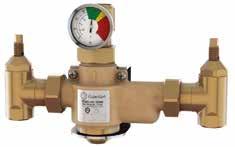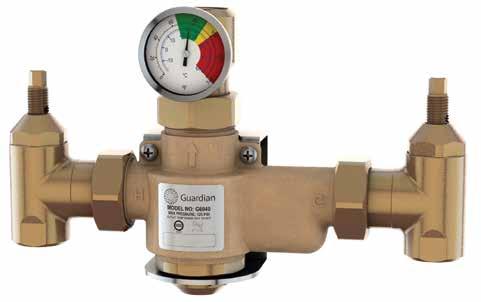
3 minute read
Emergency showers
Is your emergency shower offering COLD comfort? Dalton International explains the importance of meeting relevant Standards that stipulate tepid water delivery.
Emergency showers and eyewashes offer critical first response for any business that stores or uses hazardous substances. In the event of a chemical emergency where corrosive or toxic substances splash onto someone’s face or body, the person needs to be able to reach an emergency shower or eyewash within 10 seconds and flush the affected area for at least 15 minutes.
A rapid response to chemical splashes to the face and body with a deluge of water from an emergency shower and eyewash that meets the appropriate performance standards can be the difference between a close escape or permanent damage and disability. But what happens if the water coming out of your emergency shower and eyewash is so cold you can’t stay under it?
NEW G6000 SERIES THERMOSTATIC MIXING VALVES

Specifically designed for use with Emergency Showers and Eyewashes.
Set water temperature to ensure water is “tepid” (16 - 38°C) meeting the AS4775 Standard.
Two Models available: • G6020 with 49 Litres per minute capacity • G6040 with 189 Litres per minute capacity
To receive our Guardian catalogue and price list for plumbers text “safety” to 021 589 070. For more information contact: Dalton International on 0800 323 223 or visit us online at www.daltoninternational.co.nz
You may not store hazardous substances on this kind of scale, but if you do store or use them in your business, emergency showers and eyewashes can be the difference between a close escape and permanent damage or disability should someone get splashed by chemicals.
Why tepid water is a must Both AS4775 (the Australian Standard) and ANSI Z 358.1 (the American Standard) stipulate that all emergency showers and eyewashes must deliver ‘tepid’ water. Tepid is defined as being between 16°C to 38°C and is important because water that is too cold could lead to the patient stopping treatment early, whilst water that is too hot could speed up chemical reactions with the skin before the chemicals can be properly flushed away.
In New Zealand, most emergency showers and eyewashes are connected to the mains cold water supply. Cold water temperatures vary across the country, with winter temperatures likely to be significantly lower than 16°C, especially the further south you head.
To make matters worse, if chemicals are stored outside, then it’s likely the emergency shower and eyewash will be installed close to where the potential danger lies. This could compound the problem of cold-water usage, as the patient may also be exposed to elements, including wind chill.
In order to meet the requirement of tepid water delivery set out in the standards, it will be necessary in many instances to install a thermostatic mixing valve with the emergency shower and eyewash. The mixing
In many cases, a thermostatic mixing valve will be needed to ensure the required tepid water delivery.

valve must do more than just allow you to set the outlet temperature. It must also have enough capacity to deliver the required flow rates as set out in the standards, which are a minimum 75.7 litres per minute for emergency showers and 11.4 litres per minute for emergency face/eyewashes.
Ensuring a cold-water bypass In addition, it’s important that any loss in cold or hot water supply is treated differently. A loss of hot water should result in a ‘cold-water bypass’, so the emergency shower and eyewash will still operate. However, in the event of a loss of cold water, the mixing valve should shut off to avoid scalding the patient.
When it comes to installing emergency showers and eyewashes, it’s important that the plumber understands the requirements of the two Standards (AS4775 and/or ANSI Z 358.1). As well as installation in the correct location, understanding the required flow rates and water temperature is also critical.
About the author: Dalton International is the New Zealand agent for Guardian Safety Showers and Eyewashes which includes a range of thermostatic mixing valves. If you’d like any advice on what the Standards require and how you can meet them, talk to the team at Dalton International on 0800 323 223 or visit daltoninternational.co.nz










